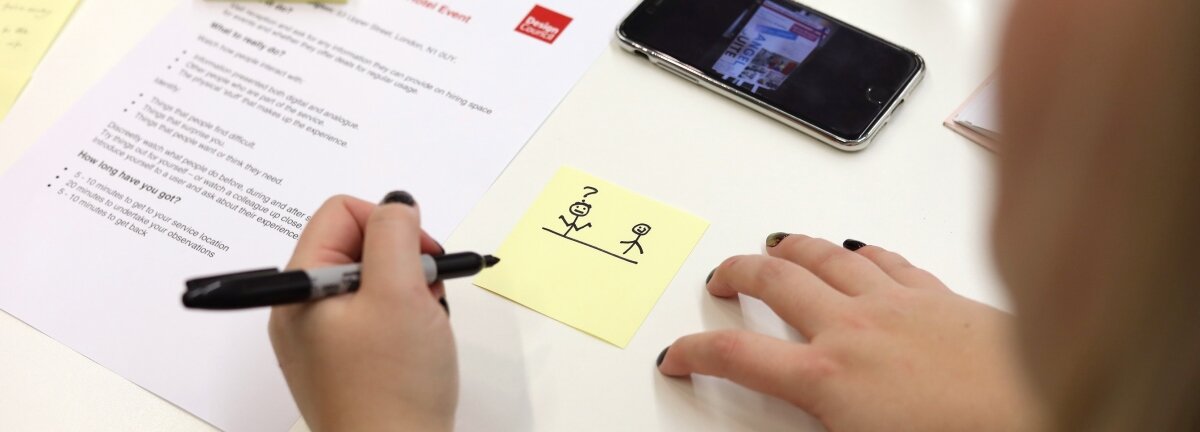Five things we learned at Design in the Public Sector

Ellen Care is a Transformation and Change Officer for the London Borough of Bexley. In early 2018 Bexley was one of 13 local authorities across England participating in our Design in the Public Sector programme. Bexley applied with an ambition to use design thinking to support them develop a co-production model to prevent social isolation and loneliness for people in later life.
Here, Ellen gives us her top 5 things she will take from her time on the programme.
In February this year, a multi-organisational team from Bexley embarked on the first Public Health themed incarnation of the Design in the Public Sectorprogramme, run by the Design Council and funded by the LGA.
Staff from the Council’s Transformation & Change and Community Partnerships teams joined colleagues from Bexley Voluntary Service Council and NHS Bexley Clinical Commissioning Group for a series of five workshops exploring the design process.
Whilst we started to prototype some initial ideas ahead of the final workshop in May, this work will continue well beyond the programme. Here are a few of the reflections we’ll be taking with us.
Reframing the challenge doesn’t mean you got it wrong
One of our first activities was to plot where in the Double Diamond we thought our project sat currently, based on the work we’d done so far. It’s easy to assume that having written an application and formed a brief for the project, we were at the mid-point, ready to move into the second Develop-Deliver diamond.
However, the programme made a real effort to bring us back to the start and focus our work in the first diamond. Reframing and redefining our project goal was an ongoing task. Each time we re-wrote the challenge, we weren’t ‘correcting’ a previous mistake, but reinterpreting the new things we learned to help us move forwards.
Get out of the building
The key points where our project changed direction often hinged on the insight we’d gained by getting out and talking to people affected by the issues we were exploring. Whilst we had a lot of professional expertise and knowledge related to the services currently provided, the programme encouraged us to ensure we understood the lived experience of real people, and use this as our starting point for developing something different.
Going out to conduct interviews and focus groups was really personally rewarding and has left a lasting impression in each of us of the people we met.
Working visually gets you all on the same page (or post it)
Coming from different organisations and teams meant each member of our project team had a slightly different view of the challenge, and we each interpreted information, opportunities and problems differently. Working on flipcharts, post its and large templates stuck on the wall gave us the same blank canvas to start from and visually articulating our ideas made them easier to understand, discuss and refine.
The negotiation of different perspectives into a single team position wasn’t always straight-forward, but working visually certainly made it a quicker process than it may otherwise have been.
Take the time to do something differently
Like everyone working in public services, our team members were busy people working on multiple projects, with many demands on their time. Having an externally facilitated programme that we’d all committed to in advance meant we made the time to work together and had the space to experiment with new techniques. A whole day at a time to really get into the work felt like a luxury, but we know we learnt and achieved a lot through the intensity.
Back in the office, it may be harder to protect time and achieve this focus, but we’re committed to supporting one another to so as far as we can.
Share your tools and stories
Presenting back to the other project teams on our cohort gave us lots of opportunities to practice telling the story of our project and our vision for the future. We’ve built on this since we’ve been back in the office and have been sharing our insights across our organisations.
Having seen the benefits of the design methods for ourselves, we’re also keen to embed these across our organisations and techniques like Rose-Thorn-Bud are already starting to pop up in different meetings.
Overall, the programme provided us with a series of innovative and engaging research methodologies and tools to help facilitate design thinking so that we approach complex public health challenges in more creative, person centred ways.
Thank you to everyone at the Design Council, the LGA and the rest of the Southern cohort for a great experience on the programme, and we look forward to sharing our progress with you.
Design in the Public Sector aims to help local authorities commission and deliver improvements to public health services. The programme builds an understanding of how design practices can enable local government professionals to shape and deliver improved services.
Subscribe to our newsletter
Want to keep up with the latest from the Design Council?
